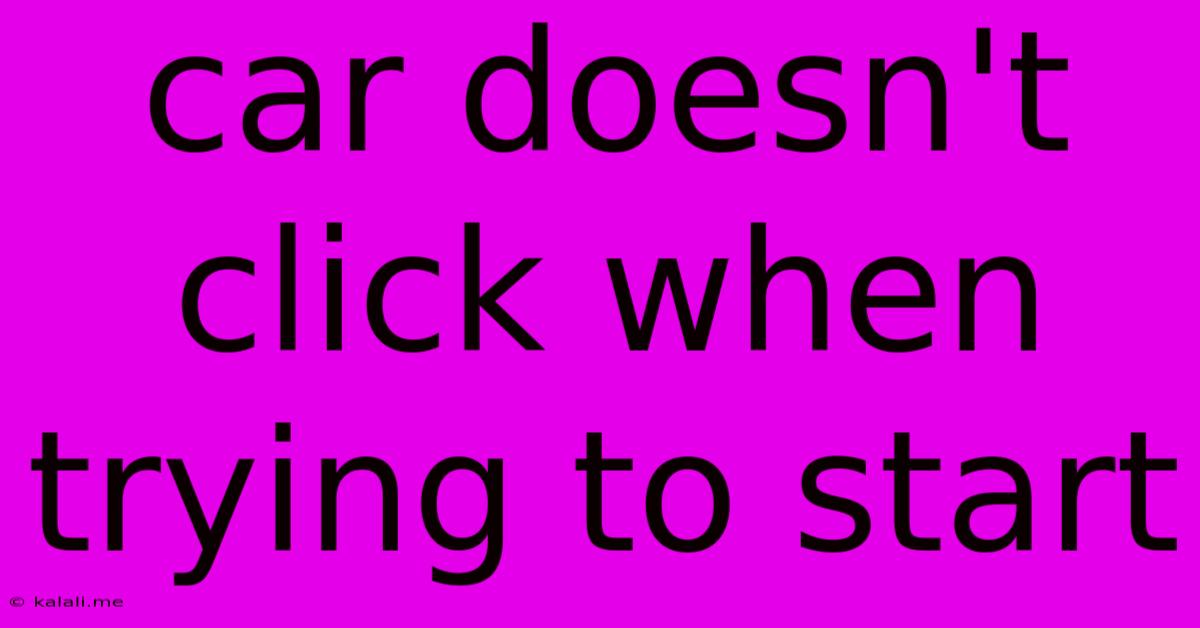Car Doesn't Click When Trying To Start
Kalali
Jun 03, 2025 · 3 min read

Table of Contents
Car Won't Start: Troubleshooting a No-Click Scenario
Your car is dead. You turn the key, and… nothing. No cranking sound, no engine sputter, just silence. This dreaded "no-click" scenario is a frustrating experience, but before you panic and call a tow truck, let's troubleshoot this common car problem. This article will guide you through the most likely culprits and help you diagnose the issue, potentially saving you time and money.
What causes a car to not click when you try to start it? The absence of even a clicking sound usually points to a problem with the battery, the starter motor, or the connection between the two. However, other factors, such as a faulty ignition switch or even a blown fuse, could also be at play.
1. Check the Battery
The most common cause of a no-click start is a dead or weak battery. This is the first thing you should check.
- Visual Inspection: Look for any obvious signs of damage, like corrosion on the battery terminals. White, powdery buildup is a clear indicator of corrosion and needs to be cleaned. Use a wire brush or baking soda and water solution to clean the terminals thoroughly.
- Battery Voltage Test: The easiest way to check your battery is with a voltmeter or multimeter. A healthy car battery should read around 12.6 volts when not in use. Anything significantly lower suggests a weak or dead battery. You can test this voltage directly at the battery terminals.
- Jump Start Attempt: If you have jumper cables and another car, attempt a jump start. If the car starts successfully, it confirms a dead battery. If not, the problem lies elsewhere.
2. Inspect the Starter Motor
The starter motor is responsible for cranking the engine. A faulty starter can manifest as a no-click situation. However, accessing and testing the starter is a more complex process usually requiring some mechanical knowledge.
- Listen Carefully: Even a faint click might be audible. A weak click suggests a problem with the starter motor itself or its connection.
- Tap the Starter (Caution!): As a last resort, carefully tap the starter motor with a hammer or mallet (only if you're comfortable doing this and understand the risks). This can sometimes temporarily resolve a connection issue, but it's not a permanent fix.
3. Examine Connections and Cables
Loose or corroded connections between the battery, starter motor, and other electrical components can prevent the electrical current from flowing properly.
- Check Cables: Inspect all battery cables for damage, fraying, or loose connections. Securely tighten any loose connections.
- Clean Terminals: Thorough cleaning of the battery terminals is crucial. Corrosion acts as an insulator, preventing electrical current from passing.
4. Consider the Ignition Switch
The ignition switch is responsible for sending power to the starter motor. A faulty ignition switch can prevent the starter from engaging. Diagnosing a faulty ignition switch usually requires more advanced electrical testing.
5. Check Fuses
While less likely to cause a complete no-click scenario, a blown fuse related to the starting system can sometimes interrupt the current flow. Consult your car's owner's manual to locate and check the fuses related to the starting system (starter motor, ignition).
6. The Solenoid
The starter solenoid is the electromechanical switch that activates the starter motor. Problems with this component can result in no click, a single click, or a clicking sound that doesn't start the engine. Testing the solenoid usually requires an understanding of automotive electrical systems.
When to Call a Mechanic:
If you've checked all of the above and still haven't identified the problem, it's time to call a qualified mechanic. They have the tools and expertise to diagnose more complex electrical issues accurately and safely. Attempting advanced troubleshooting without the proper knowledge and tools could potentially cause further damage to your vehicle.
This guide provides a starting point for troubleshooting a "no-click" situation. Remember safety first, and don't hesitate to seek professional help if needed. A quick diagnosis can save you significant time and potential expense down the road.
Latest Posts
Latest Posts
-
Can I Add A Second Ac Unit To My House
Jun 05, 2025
-
Why Is Thorough Watering Plants Good
Jun 05, 2025
-
How To Multithread A For Loop Java
Jun 05, 2025
-
Combine Pdf With Table Of Contents
Jun 05, 2025
-
In Accordance With Or In Accordance To
Jun 05, 2025
Related Post
Thank you for visiting our website which covers about Car Doesn't Click When Trying To Start . We hope the information provided has been useful to you. Feel free to contact us if you have any questions or need further assistance. See you next time and don't miss to bookmark.